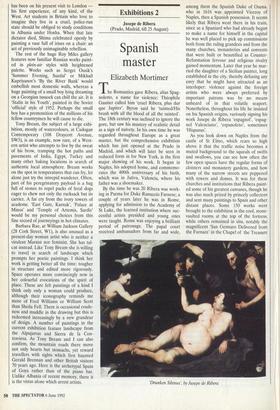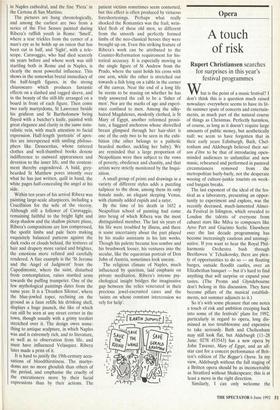Exhibitions 2
Jusepe de Ribera (Prado, Madrid, till 25 August)
Spanish master
Elizabeth Mortimer
The Romantics gave Ribera, alias Spag- noletto, a name for violence: Theophile Gautier called him 'cruel Ribera, plus dur que Jupiter'. Byron said he 'tainted/His brush with all the blood of all the sainted'. The 18th century was inclined to ignore the gore, but saw his mastery of realistic detail as a sign of naivety. In his own time he was regarded throughout Europe as a great master, but the comprehensive exhibition which has just opened at the Prado in Madrid, and which will later be seen in reduced form in for New York, is the first major showing of his work. It began in Naples, his adopted home, and commemo- rates the 400th anniversary of his birth, which was in Jativa, Valencia, where his father was a shoemaker.
By the time he was 20 Ribera was work- ing in Parma for Duke Ranuccio Farnese; a couple of years later he was in Rome, applying for admission to the Academy of St Luke, the learned institution where suc- cessful artists presided and young ones were taught. Rome was enjoying a brilliant period of patronage. The papal court received ambassadors from far and wide,
among them the Spanish Duke of Osuna, who in 1616 was appointed Viceroy of Naples, then a Spanish possession. It seems likely that Ribera went there in his train, since as a Spaniard who had already begun to make a name for himself in the capital he was well placed to pick up commissions both from the ruling grandees and from the many churches, monasteries and convents that were built or beautified as Counter- Reformation fervour and religious rivalry gained momentum. Later that year he mar- ried the daughter of a Sicilian painter, long established in the city, thereby defusing any envy that he might have attracted as an interloper: violence against the foreign artists who were always preferred by important patrons was by no means unheard of in that volatile seaport. Nonetheless, throughout his life he insisted on his Spanish origins, variously signing his work Jusepe de Ribera 'espagnol', 'espag- nol Valenciano', 'espanoleto', sometimes
As you look down on Naples from the castle of St Elmo, which rears so high above it that the traffic noise becomes a muted background to the squeals of swifts and swallows, you can see how often the few open spaces have the regular forms of cloisters and monastery gardens, and how many of the narrow streets are peppered with towers and domes. It was for these churches and institutions that Ribera paint- ed some of his greatest canvases, though he was also much prized by princely collectors and sent many paintings to Spain and other distant places. Some 150 works were brought to the exhibition in the cool, stone- vaulted rooms at the top of the fortress, while others remained in situ, notably the magnificent 'San Gennaro Delivered from the Furnace' in the Chapel of the Treasure 'Drunken Menus, by Jusepe de Ribera in Naples cathedral, and the fine 'Pieta' in the Certosa di San Martino.
The pictures are hung chronologically, and among the earliest are two from a series of the Five Senses painted during Ribera's raffish youth in Rome: 'Smell', where a tear trickles from the corner of a man's eye as he holds up an onion that has been cut in half, and 'Sight', with a tele- scope. Caravaggio, who had died scarcely six years before and whose work was still • startling both in Rome and in Naples, is clearly the most powerful influence. This shows in the somewhat brutal immediacy of the half-length figures, in the strong chiaroscuro which produces fantastic effects on a slashed and ragged sleeve, and in the beauty of the still-life arranged on a board in front of each figure. Then come two early martyrdoms, St Lawrence beside his gridiron and St Bartholomew being flayed with a butcher's knife, painted with great elegance and clarity in the same natu- ralistic vein, with much attention to facial expression. Half-length 'portraits' of apos- tles are interspersed with smiling philoso- phers like Democritus, whose tattered clothes and well-thumbed books denote indifference to outward appearances and devotion to the inner life, and the content- ment thereby engendered. A bald, grey- bearded St Matthew pores intently over what he has just written, quill in hand, the white pages half-concealing the angel at his side.
Within ten years of his arrival Ribera was painting large-scale altarpieces, including a Crucifixion for the wife of the viceroy.
Although still a follower pf Caravaggio, remaining faithful to the bright light and deep shadow and the shallow picture plane, Ribera's compositions are less compressed, the spotlit limbs and pale faces making exquisitely balanced patterns against the dark rocks or clouds behind, the textures of hair and drapery more varied and brighter, the emotions more refined and carefully rendered. A fine example is the 'St Jerome and the Angel of Judgment' from the Capodimonte, where the saint, disturbed from contemplation, raises startled arms towards the puffing trumpeter. One of the few mythological paintings dates from the same year. It is a 'Drunken Silenus', where the blue-jowled toper, reclining on the ground as a faun refills his drinking shell, displays a huge paunch, the like of which can still be seen at any street corner in the town, though usually with a grimy teeshirt stretched over it. The design owes some- thing to antique sculpture, in which Naples was and is extremely rich, and to literature, as well as to observation from life, and must have influenced Velasquez. Ribera later made a print of it.
It is hard to justify the 19th-century accu- sations of bloodthirstiness. The martyr- doms are no more ghoulish than others of the period, and emphasise the cruelty of the executioners more by their facial expressions than by their actions. The patient victims sometimes seem contorted, but this effect is often produced by virtuoso foreshortenings. Perhaps what really shocked the Romantics was the frail, wrin- kled flesh of these old men, so different from the smooth and perfectly formed limbs of the neo-classical heroes they were brought up on. Even this striking feature of Ribera's work can be attributed to the Counter-Reformation requirement for his- torical accuracy. It is especially moving in the single figure of St Andrew from the Prado, where the saint holds his cross with one arm, while the other is stretched out towards a fish lying on a table in the corner of the canvas. Near the end of a long life he seems to be musing on whether he has truly answered the call to be a 'fisher of men'. Nor are the marks of age and experi- ence confined to men. Among the silky- haired Magdalenes, modestly clothed, is St Mary of Egypt, another reformed prosti- tute, a haggard anchoress whose shrivelled breast glimpsed through her hair-shirt is one of the only two to be seen in the exhi- bition (the other belongs to a pathetic bearded mother, suckling her baby). We are reminded that a large proportion of Neapolitans were then subject to the vows of poverty, obedience and chastity, and that artists were strictly monitored by the Inqui- sition.
A small group of prints and drawings in a variety of different styles adds a puzzling tailpiece to the show, among them its only female nude, an elegant sleeping Venus, with clumsily added cupids and a satyr.
By the time of his death in 1652 a Neapolitan school of painting had come into being of which Ribera was the most distinguished member. The last six years of his life were troubled by illness, and there is some uncertainty about the part played by his studio assistants in his late works. Though his palette became less sombre and his brushwork looser, his ventures into the secular, like the equestrian portrait of Don John of Austria, sometimes look uneasy.
The religious climate of Naples, much influenced by quietism, laid emphasis on private meditation. Ribera's intense psy- chological insight bridges the imaginative gap between the relics venerated in their precious jewel-encrusted cases and the `saints on whose constant intercession we rely for help'.



































































 Previous page
Previous page